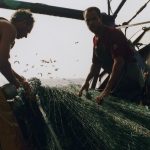With the collection of bait now regulated by the Inshore Fisheries and Conservation Authorities (IFCA’s) as a sea fisheries resource, management from Southern IFCA required a solution that would provide quantitative and reliable data for bait dragging activities unique to Poole Harbour in southern England.
There was a lack of real evidence regarding the level at which such activities were occurring as well as the impact to the environment, so innovative solar battery-powered vessel monitoring systems (VMS) from SuccorfishM2M were fitted to vessels as part of a EEF-funded project to encourage a collaborative approach between fishermen, conservationists and marine management.
Bait dragging is an activity which is believed to be unique to Poole Harbour and involves collecting bait via one or two specially designed hooked, metal drags which are deployed from a vessel. This activity is exclusively carried out for commercial purposes supplying national suppliers of bait and occurs primarily over intertidal and sub-tidal areas where the sediment environment consists of mud or muddy sand.
The project aimed to conserve the resources exploited by bait dragging activities and contribute to achieving the conservation objections of a European Marine Site (EMS).
Technology-driven SuccorfishM2M SC2-VMS hardware used GPS and satellite technology to deliver a precise, real time picture of bait dragging vessels in harbour areas every ten minutes over a one-year period. Data obtained using specialist online software also demonstrated vessel speed, location to within two metres and environmental conditions in relation to harbour location.
‘Prior to this, bait collection for both personal and commercial purposes was not the subject of fisheries legislation and as such, was largely unmanaged,’ commented Tom Rossiter, Head of Marine at SuccorfishM2M. ‘Southern IFCA, the management authority at Poole Harbour, were able to collate highly valuable evidence in order to assess the impact of bait dragging activities on local sediment and the natural habitat.Quantified data obtained can now be used to effectively and proactively protect future natural resources and help to monitor any overlap between fishing activity and the management of the area’s sensitive features and native species.’
‘While being innovative and technology driven, our iVMS solutions can be applied to many different and bespoke fisheries projects from monitoring global fishing fleets to surveying localised waters. It is an all-encompassing solution that meets a growing need to fill such data gaps in commercial fisheries worldwide. The SC2-VMS system allows marine managers to develop strategies on the best available evidence,’ Tom Rossiter said.









